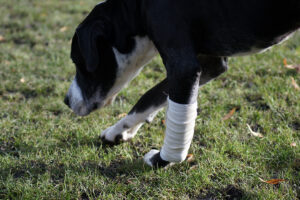
Radius and ulna fractures in dogs can be scary injuries.
Radius and ulna fractures in dogs are among the most common orthopedic injuries, particularly in smaller breeds. These fractures typically result from trauma such as being hit by a car, falling from a height, or other high-impact accidents. Prompt diagnosis and treatment are critical to ensure proper healing, restore mobility, and minimize long-term complications. We are going to discuss the surgical techniques used to treat these fractures and what to expect during the recovery process.
Understanding Radius and Ulna Fractures in Dogs
The radius and ulna are the two long bones in a dog’s forearm. Due to their role in bearing weight and enabling motion, fractures in these bones can significantly impact a dog’s ability to walk or stand. These fractures can vary in severity—from simple, clean breaks to complex, comminuted (multiple-piece) fractures.
Common signs of radius and ulna fractures in dogs include:
- Sudden lameness or inability to bear weight
- Swelling in the leg
- Pain when the leg is touched or manipulated
- Visible deformity in severe cases
Diagnosis typically involves a physical examination followed by X-rays to determine the type, location, and severity of the fracture.
Surgical Techniques for Radius and Ulna Fractures
Surgery is often the preferred treatment for radius and ulna fractures in dogs, especially when the bones are displaced or the fracture is unstable. The specific technique used depends on the nature of the fracture and the size of the dog.
Bone Plating
This is one of the most reliable methods for stabilizing radius and ulna fractures. A stainless steel or titanium plate is screwed into the bone across the fracture site. Bone plating offers excellent stability and allows for quicker functional recovery.
External Fixation
This technique involves placing pins or wires through the skin and bone on either side of the fracture, which are then connected externally with a rigid frame. It’s particularly useful for open fractures or when the soft tissue is compromised. External fixation is adjustable and can be less invasive in certain cases.
Locking Plate Systems
For more complex fractures or dogs with special needs (such as older dogs with poor bone quality), locking plate systems offer superior mechanical stability and promote better healing outcomes.
Recovery and Rehabilitation
Post-surgery care is critical for the successful treatment of radius and ulna fractures in dogs. Here’s what pet owners should expect during recovery:
Hospital Stay and Initial Recovery
Most dogs stay at the veterinary hospital for a day or two following surgery. Pain management and wound care are priorities during this period. Owners will receive instructions on how to care for the incision site and administer any prescribed medications.
Restricted Activity
Dogs will need to be strictly confined for several weeks post-surgery to avoid stressing the repaired bone. This often means crate rest or confinement to a small area to prevent jumping, running, or rough play.
Follow-Up Visits
Veterinarians typically schedule follow-up X-rays every 3–4 weeks to monitor bone healing. Adjustments to recovery protocols may be made based on these images.
Physical Therapy
Once the bone begins to heal, gentle physical therapy may be introduced. This can include passive range-of-motion exercises, short leash walks, and eventually, more structured rehab activities like underwater treadmill therapy.
Healing
Most radius and ulna fractures in dogs heal within 8 to 12 weeks, although recovery may take longer in older dogs or those with more severe injuries.
Preventing Complications
To ensure a smooth recovery, it’s essential to:
- Follow all postoperative care instructions from your veterinarian
- Keep the surgical site clean and dry
- Prevent the dog from licking or chewing the incision (use an e-collar if necessary)
- Monitor for signs of infection or implant failure (e.g., swelling, discharge, or pain)
- Avoid premature return to normal activity
Getting Care is Crucial
Radius and ulna fractures in dogs can be serious, but with timely surgical intervention and proper post-operative care, most dogs go on to make a full recovery. Whether your dog is a tiny Chihuahua or a mid-sized Terrier, orthopedic surgery can restore mobility and improve quality of life. Always consult with a board-certified veterinary surgeon for the best outcomes.
Trust Maryland Veterinary Surgical Services With Your Companion’s Health
Your companion’s health is important, and the team at MVSS is ready to provide the best care possible for your furry family. We are dedicated to combining comprehensive exams and assessments with informative and honest discussions of your companion’s care. Once we have worked with you to decide on the best course of action for your dog, our professionals will use their surgical expertise to work towards the goal of giving your companion an active and pain-free life. We are proud to serve loyal companions in Catonsville and Baltimore. To learn more about our services, give us a call at 410-788-4088 or visit us online. For more information and tips for dog health, follow us on Facebook and Pinterest.
